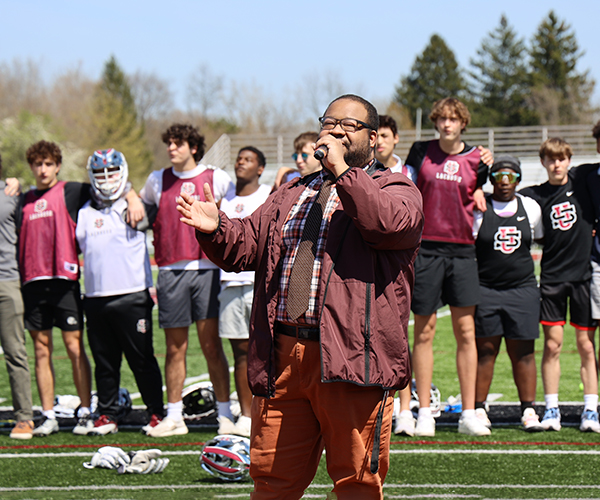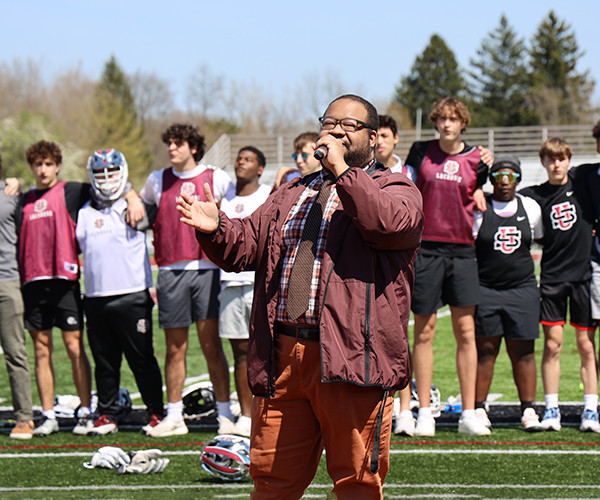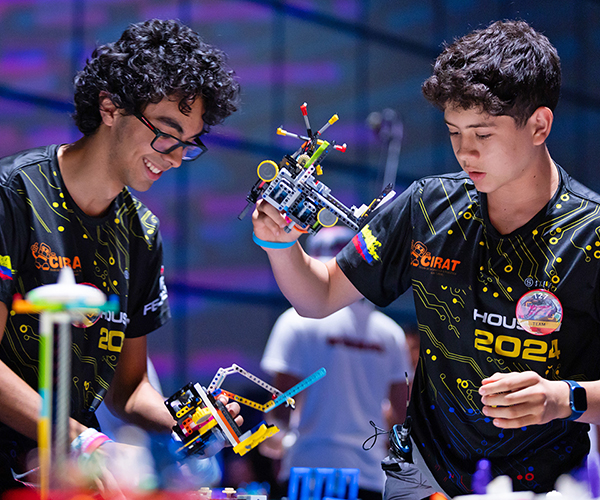From kindergarteners learning Mandarin Chinese to high school juniors splicing DNA cells, private schools in Northeast Ohio have taken academics way beyond textbook and paper to give students the opportunity to expand their knowledge and increase their opportunities.
Soaking It Up
A flurry of blue and green plaid rushes into the classroom. Kindergarteners in Michelle Statham's class at Laurel School, an independent school for girls in Shaker Heights, know what today is. It is Wednesday, one of the three days that Shuling Tai comes to teach them a lesson in Mandarin Chinese.
Laurel School, known for challenging its students, decided to introduce a foreign language into the primary classes. "We looked into different languages and one of our teachers went to a conference where they presented Chinese," says Joan Moody, associate director of the lower school at Laurel. And it made sense. "Children need to understand China culturally and it is something they are not familiar with."
Chinese is the third most spoken language in the world and an invaluable tool to possess. Moody points out that China is becoming more involved in relations with the United States and the lessons will give the girls an advantage in their careers.
So Laurel School recruited Shuling - one of two Mandarin Chinese teachers in the school - to teach her native language to the elementary school students.
"We were very lucky to find her," Moody says. "She is really good with keeping the girls active."
Shuling patiently waits for the girls to quiet down as they form a circle around her. She begins reciting words and the children respond eagerly but very softly.
"Use our Laurel School girl morning voice," she says. "Be clear. Be loud."
One of the girls sheepishly raises her hand and asks if they can sing a song. Shuling obliges as she leads the song, a Mandarin Chinese version of "Head, Shoulders, Knees and Toes."
Some of the girls stumble across the words in the fast-paced song that includes physical movements. "You have to work ahead in English to switch to Chinese," Shuling says. "Pronounce every word clearly."
They repeat the song many times, to the girls' delight.
And parents have been delighted that their daughters are learning the language. On one particular trip, a student started speaking Chinese to some other passengers, Moody recalls. The girl's father overheard and was "blown away," she says.
The school encourages parents to review words with their daughters, which helps the girls grasp them and may teach their parents a thing or two. "It is so natural at an early age, they have no hang-ups," says Moody. "It is amazing to see them pick it up."
Chinese is a tonal language - in which different tones distinguish different meanings - with 420 syllables that can be modified by using any of four tones. Thus, it is easy to distinguish between the Chinese characters and English, Moody says, allowing the girls to learn both languages at once. "It is stretching to use another part of the brain," she says.
Unlike English, which is primarily a left-brain function, Mandarin Chinese seems to activate both the right and left temporal lobes, according to a Wellcome Trust study. By employing the creative and logical sides of the brain, mental flexibility will be strengthened, Shuling says, meaning the Mandarin Chinese may help enhance musical training and improve their artistic side.
The written language includes more than 20,000 characters. But Shuling believes it is important for the girls to write the symbols correctly. "It shows the history behind the characters," she says.
The girls also learn about the culture and ways of life in China. From tracking pandas at the zoo to drawing Chinese trees in art to celebrating the Chinese New Year, they become immersed in a different culture.
"We try to connect it and integrate it into whatever is going on in the normal classroom," Moody says, pointing out an example of the family unit where the children learned to spell family members' names in Chinese.
Shuling says it is easier for children to learn a foreign language because they are not set in their ways and their brains soak up information like sponges. "Their brain is still molding. It makes every sense to start early."
Laurel School currently offers Mandarin Chinese from kindergarten through fourth grade and again in ninth through 12th grade. The goal, says Moody, is to one day have the language available at every level in the school.
After her 30 minutes is up, Shuling says goodbye to her students. The girls, with their minds still in Chinese mode, say "Zà ijià n."
Algebra Applied
The eighth-graders at Lake Ridge Academy, a co-ed private school in North Ridge- ville, enter Fran Hamper's classroom with smooth, shiny desks pushed together in quads and a poster with the calculation of pi wrapped around the top of the room. They are fresh off winter break and talk to one another about their vacation.
They plop down into blue chairs and place their algebra textbooks and calculators on the desks as they wait for their Augmented Algebra class to begin. But these textbooks are not filled with lines and lines of abstract equations; instead, they are filled with story problems that resemble real-life applications.
From figuring out if the duration of an airplane flight and its distance correlate to each other to investigating the annual interest earned on a $2,000 investment, these students are using their mathematics in situations they could face in the future.
"It's easier to show, rather than tell," says Hamper, who is also head of the math department. "We have them explore informally rather than give them problems. It shows that math can be creative."
Today they are continuing their work on linear regression, which they started before the winter break. The students collected shoe size and height data from family and friends to find if there is a correlation between the two variables.
"It's more rewarding to work through a problem than make no effort to get it," says Hamper. "It's like light bulbs go off in their heads."
Hamper gives a brief overview of linear regression, but when she asks a question, the students hesitate to answer. "We need to wake that brain up after two weeks of video games and television," she says.
In order to participate in Augmented Algebra, the students had to have teacher recommendations and take a placement test. Otherwise, the course is like any other math class: the students meet every day, are assigned homework and take tests on the material.
"Most of theses students will go on to pursue careers in the medical and science fields," Hamper says. "What we are aiming here for is to apply the math and put it into context so it is not all abstraction. The sophistication of the material is very high."
Diane Colley, a sophomore at Lake Ridge, says taking Augmented Algebra when she was in eighth grade helped her realize what she was doing with the numbers. "You get to see what the point of it all is," she says. "I have a better sense of what it means and I can see how it was applied. It's not just a bunch of random numbers anymore."
Once the directions are given, the students break out their calculators to come up with their equations. "Start with point-slope formula and turn it into y = m x + b," Hamper says. "Talk about the process with each other, but you will all have different answers."
After the calculations, Hamper plots their points on a graph with an overhead projector. The students get excited when their predictions are pretty close to reality.
"It challenges them," she says. "They will understand the process more if they can relate it to a life experience."
She says the course is better for the students in the long run, instead of allowing them to reach calculus earlier than other students.
"We wanted to do something in terms of developing, broadening and deepening math. It prepares them for the thought processes in upper classes," Hamper says. "We can do something special with these kids. We have the time to tackle topics you don't get to do."
Colley agrees. "It helps cement concepts more," she says. "From statistics to probability to pre-calculus." It also helped her score in the 93rd percentile on her PSAT, she says.
In the final moments of class, Hamper writes each student's equation on the board and asks which one looks the best; in unison they all say, "Mine!"
Dissecting DNA
Gloves on? Check. Micropipettes? Check. Azotobacter vinelandii? What?
To anyone else, that would be the reaction when presented with the nitrogen-fixing bacteria. Most people would not even know what a nitrogen-fixing bacteria is, let alone how to find the DNA sequence of it. But to the Genomics class at Benedictine High School, an all-boys college-preparatory school in Cleveland, it's a piece of cake.
Thousands of dollars worth of scientific equipment has been brought into their lab through Hiram College and a $1.2 million grant from Howard Hughes, which allow the juniors to study and conduct experiments. The class has collaborated with Hiram College for the past three years and is in the middle of its fourth year of research, with each class focusing on a different project.
While the students do most of the work at school, the DNA is sent to Hiram to be sequenced and the students take a trip every year to see the equipment and explore the campus.
"We are taking their knowledge and saying, "You can do this,' " says teacher Diana McBeath. "It was so successful that we've done it every year."
Dressed in navy blue polo shirts and khakis, the boys wrestle impatiently in their seats as the snow falls outside. They are anxious to begin their work with the bacteria, but first they must learn more about the structure of the cell. With thick textbooks poised on their desk, class begins with McBeath rattling off terminology.
"Why does DNA move toward positive electrons?" asks McBeath, who is co-chair of the science department. The students are eager to offer an answer.
"In the past that would be all you did, but now you go further," McBeath explains after quizzing the students on restriction enzymes.
"This helps kids to go on and apply to grad school. They are confident. They are getting a taste of it," McBeath says. "By the time they leave us they have a good background. They've learned skills that cross all disciplines."
Once they have all the basic information down, the real fun begins with experiments conducted to mutate the bacteria.
By isolating and manipulating the bacteria through a series of steps and procedures, they will eventually be able to find the genetic code.
McBeath, in a white lab coat and blue latex gloves, begins explaining the procedure to the class. From incubating the bacteria in a digital dry bath to using a vortex and centrifuge machine, the students all work with their own tubes of bacteria.
"Add ethanol and vortex it," she says. During this process, the transposon, a piece of DNA that acts as a biological mutagen, will jump randomly in the genome, allowing the students to follow it and study it.
Senior Jeff Kuerbitz, who took regular biology as a freshman, says Genomics helped him decide to major in biology in college. "This is a great opportunity to learn more," he says. "The research is a valuable opportunity you don't get to see anywhere else."
While he has learned about gel electrophoresis and mutation, Kuerbitz says his greatest lesson is not scientific at all. "You learn more from failures and mistakes than successes," he says. "I was always fascinated by science, and this class has increased my curiosity."
Mission accomplished? Check.
"They are used to looking into books for answers. I do see excitement from them and to see high school boys get excited about anything?" McBeath trails off. "It's a win-win situation."



